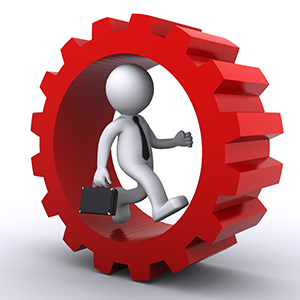“Building an intrapreneurial culture might be one of the toughest managerial challenges, but it is an essential part of dealing with change.” -Peter Vogel, 2018
By Trish “Doc” Holliday
Between individual and family unrest, public and private organizations struggling to survive, budget cuts of all sizes, IT adaptations, an anxious public, and struggles to attract and retain talent amid such uncertainty, leaders face unique challenges on numerous fronts. As these challenges become more complex, many organizations are looking to pause, pivot, rethink and/or reimagine what business could and should look like in the future. This global pandemic has given leaders, who are willing to embrace the moment, the opportunity to think about structure, work environments, talent placements, product and service delivery, and customer relationships. Chip Heath states, “Defining moments rewire our understanding of ourselves or the world. In a few seconds or minutes, we realize something that might influence our lives for decades…(The Power of Moments, 2017).” We are in a defining moment as leaders of organizations and teams. As we face uncertainty, leaders become the spotlight and it is this type of moment there is opportunity to invite new ways of thinking and doing.
Avoiding Functional Fixedness
For years organizations have missed opportunities to address what is called “innovation antibodies” within the walls of their businesses, which has kept innovation and creativity at bay. So-called “innovation antibodies” are famous for their ability to hinder creative thought and destroy ideas entirely. These antibodies are typically found in departments who are least interested in change, innovation, and disruption of any kind. These departments are demonstrating “functional fixedness” which is defined as a cognitive bias that limits a person to use an object only in the way it is traditionally used.
Functional fixedness is often found in work environments where leaders suppress creativity, discourage imagination, and thinking outside the box. An HBR article entitled “Get the Corporate Antibodies on Your Side” by Mitra Best, encourages leaders to confront head-on those who seek to squelch ideas and innovation and invite them instead to be part of new approaches and different solutions. Forward thinking organizations are finding new ways to work around those innovation antibodies and overcoming the functional fixedness barriers.
Embracing the Intrapreneurial Mindset
Effective leaders understand the importance of creating a workplace where employees feel empowered to be critical thinkers and stretch beyond “what is” to “what could be” in order to drive efficiencies in product and service delivery and strengthening customer buy-in. Developing employees to be intrapreneurs is beneficial for the organization and for the employee themselves. Intrapreunership is defined as a system that allows an employee to act like an entrepreneur within a company. Intrapreneurship brings a broader vision to an established company; the vision involves changes to company traditions, processes, or products to sustain in the future (Investopedia).
Intrapreneurship helps organizations grow business and effectively accelerate and lead change. High performing individuals are attracted to innovative environments and by creating an intrapreneurial workplace, quality talent is not only easier to recruit, they are also easier to retain as they find themselves challenged and new possibilities widened.
In intrapreneurship, the major challenge that employees often face is the culture of the organization. Often, the workplace relationships and mindsets of the workforce serve as barriers for an intrapreneur. Highly effective leaders create environments where innovation and courageous thinking is encouraged and rewarded. When leaders effectively empower others and are successful in helping others become more influential in their roles, the workforce is likely to be more productive and increase the bar of success overall. Ultimately, organizations that nurture Intrapreunership from within, foster the growth of leaders across the organization.
Obstacles Hindering Intrapreneurship
So, what does it take to develop an organization that invites the intrapreneurial mindset? There are obstacles that leaders face in trying to drive innovation from within. It is important to identify these obstacles for leaders to successfully navigate and overcome them in order for intrapreneurship to be interwoven into the fabric of the organizational culture. First, attitude is everything! Effective leaders understand the importance of a positive attitude in a workplace and within the culture. Encourage employees to recognize opportunities to explore and offer new ideas that would boost effectiveness and efficiency. Second, permission is necessary! Many times we think we do not need to state that permission is granted for employees to experiment and try new ways of operating, yet it is imperative that employees hear they have permission to explore and try new ways of doing things in order for the organization to increase its effectiveness and efficiency. Third, disruption can be positive! Celebrating small breakthroughs with new ideas and ways of operating ensures that employees see the value in continuous improvement. Creating a culture of continuous improvement is not an easy task; however, the benefits of this type of culture pays off in so many ways. The organization does not get stuck in functional fixedness or become complacent with product and service delivery methods because the workforce is committed to pursuing what is most effective and most efficient for overall success. When leaders overcome these obstacles, a pathway to developing successful intrapreneurs from within is made possible. Once the path is cleared, let the ideas and innovations flow.
Catching the Intrapreneurial Spirit
In an article by Aimee Hansen, from The Glass Hammer, she offers five qualities that stoke the intrapreneurial spirit: 1) Relentless Curiosity, 2) Risk-taking creativity, 3) Daring and vocal courage, 4) Passionate and adaptable resilience, and 5) Contagious collaboration. Upon reflection, knowing these qualities, leaders can adapt their own leadership styles to embrace the intrapreneurial spirit themselves and encourage their workforce to do the same. A great exercise for a leader to facilitate with their team is to dissect the meaning of each of those qualities within their own organizational culture. For example, ask your team to tell you what “relentless curiosity” looks like in the workplace. This type of discussion helps team members identify and recognize behaviors that are associated with “relentless curiosity” and encourages them to demonstrate the behaviors within their own roles.
I remember the time my youngest son wanted gloves that fit him, and the gloves sold in stores were not suitable for someone who was challenged physically with cerebral palsy. My son did not let the fact that nobody produced gloves that were made for him stop him from exploring “what could be.” He worked on a blueprint design of a pair of gloves that would be functional for him and other kids like him. As a result, his occupational therapist and him made the gloves based on his design, and it was incredible to see the joy on his face as he knew he had created something special that would benefit other kids, not just himself. What a celebration of relentless curiosity and how it can pay off when curiosity leads to innovation! While establishment may put obstacles in the way of creativity and innovation, intrapreneurs figure out ways to climb over, creep under, squeeze around, or knock a hurdle out of the way (Deloitte, 2013). Leaders cultivate an intrapreneurial culture by fostering autonomy and empowering employees to take ownership of their work, experiment and take intelligent risks, learn from their mistakes, and develop sound problem-solving skills. Building an intrapreneurial culture might be one of the toughest managerial challenges, but it is an essential part of dealing with change (Peter Vogel, 2018). Leadership matters a great deal. An intrapreneur’s success depends in part on leaders who offer early support, advocate for new ways of thinking, and cultivate a place where there is a “let’s keep trying attitude” and innovative ideas are welcomed.

Dr. Trish Holliday, EdD, SPHR, SHRM-SCP, IPMA-SCP, CPC
Founding Partner, Holliday | Kenning
trish@hollidaykenning.com
www.hollidaykenning.com

Lucinda Kenning, MBA
Founding Partner, Holliday | Kenning
lucinda@hollidaykenning.com
www.hollidaykenning.com
